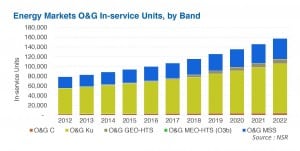Latest News

The oil and gas sector remains an attractive one for satellite companies to target. With oil companies wanting to do more video, as well as improve the conditions for workers, satellite technology plays a key role in improving operations and keeping morale amongst oil workers high.
High Throughput Satellites
One of the big questions facing oil companies is what the introduction of High Throughput Satellites (HTS) will mean for them. Ian Theophilus, general infrastructure manager, Tullow Oil, says there will be game changers for oil and gas companies when looking at satellite. “Going back to real-time data, this is going to require significant throughput. The way we operate in some of these locations in the future is going to rely heavily on an increase in throughput on satellite bandwidth technology,” he says. “My technical teams have been discussing the new offerings from O3b and Intelsat Epic for a number of weeks now. For us, it is too new, we would like to give it time to see how it beds in and how the industry takes to it, but it is certainly of interest to us. We will continue to discuss and follow the progress of these services over the coming months. All new technologies being launched and being promoted are of interest to us.”
Unlike Tullow Oil, Encana, a domestic North American on-shore operation with long-term upstream operating commitments in its areas, does not use satellite. However, the company faces many communications challenges where satellite could come into play. On the subject of HTS, Trevor Textor, telecommunications business analyst, production management and field operations, Encana Corp., says, “I think we all just expect that we will have more bandwidth in the future. All the other options are increasing their throughput as well.”
For Donald Happel, field telecoms advisor, Americas infrastructure projects, Shell Information Technology International, satellite offers a lot of potential for this sector. “Ka-band MEO satellites could very well be a boon for the industry; we will likely know more after providers have established satellite constellations next year,” he says.
But it will take time for these newer HTS systems to gain acceptance within the oil and gas community, according to Brad Grady, an analyst at NSR. The research firm expects almost 17 Gbps of demand from oil and gas end-users on HTS systems by 2022, with growth really starting to take off after 2017. Grady says the combination of higher throughputs and better prices will be a strong value-proposition within the oil and gas market that will definitely appeal to end-users. Companies like RigNet with their investment in Global Xpress, or Harris CapRock with Epic NG are making investments in HTS capacity now, Grady says, so they are well positioned to meet the continuing bandwidth growing coming from the oil and gas market.
Network Challenges
For oil companies with operations both onshore and offshore, deciding which technology to use can often be a complex equation. Despite more fiber options, Theophilus admits that with Tullow Oil’s current drilling and exploration activities across the globe, there is going to be increased demand for satellite technology to connect its remote exploration sites and seismic camps back to its corporate domain. “Over the next few years, there will continue to be an increase in the amount of satellite technology we are utilizing in some of these global frontier locations,” he adds.
However, while the demands for satellite technology are on the increase, the onset of fiber could marginalize satellite in some areas. “If you look at some of the major cities that we have presence in across the globe, and predominantly in Africa, terrestrial fiber is becoming more and more available. This includes dark fiber, which is being laid continually and aggressively. But there is an issue,” says Theophilus. “We are not going to see fiber running up the middle of a remote area to allow connection to a drilling site, which in turn will allow us to connect back to our corporate network through a local PTT. In addition to this, there is still a struggle to enforce SLA’s with some of the telcos providing fiber services. I agree we would eventually move across to terrestrial communications, but for drilling locations, both onshore and offshore, I still see a significant usage of satellite communications.”
Satellite solutions will also remain very important to Petrobras, Brazil’s major oil company. “Brazil is a country of continental dimensions with a great need for communication and integration. Besides, the growing demand for mobility can also increase the use of satellite communications. Demands for new offshore exploration of pre-salt reserves are a strong reason for using VSAT,” Firmiano Ramos Perlingeiro, head of Information and Communications Technology (ICT) at Petrobras says. “There is no doubt about the importance of satellite communication for the oil and gas industry. I believe VSAT will be more attractive.”
Figures
The good news for the satellite industry is that the increase in bandwidth demand is pretty strong. Theophilus outlines how much capacity the company will need over the next few years. “In terms of how much satellite capacity we use, we are currently utilizing approximately 50 MB of satellite bandwidth capacity. I do see that increasing over time. The prediction I am working to at the moment is somewhere in the region of 100 MB globally by the middle of next year, and possibly 150 MB by the end of next year. It is a fairly significant increase, and a lot of that demand is coming from real-time applications that are becoming more and more critical to field locations. With technology shifting to significantly more reliance on real time applications, there will be a continued drive for more bandwidth availability,” he says.
Tullow Oil is investing in exploration activities globally and in the communications services to support these activities. It will be a mix of satellite and terrestrial communications technology, according to Theophilus. “We are also taking into account the Tullow seismic activity. How we support that from a communications perspective is key to enabling the seismic teams to work efficiently in remote and difficult locations. With the increased high throughput availability in satellite technology, I believe that is something we will look to invest in down the road for seismic connectivity back to HQ. Delivering ‘Connectedness and Sameness’ regardless of location is something we in Tullow Oil are committed to,” he says.
Textor also says there will be a place for satellite for oil companies. “There will always be a place for all communications options. I think of them as tools in the toolkit. The popularity of an option will vary with the viability of other options and will be affected by how businesses operate,” he says.
Lower Prices
Both Theophilus and Perlingeiro, while saying their companies needed more satellite, also called for the industry to provide lower prices to make the overall business case more compelling. “Satellite solutions will remain very important to us, as much as they have been in the past. Petrobras has an optical fiber ring of 500 km in the Campos Basin connecting several rigs. This ring may be extended for other units in the future, but it depends on the business evolution and the economic feasibility. We expect providers of satellite communications solutions [to offer] higher performance and low delay in communication, and mainly, lower prices,” Perlingeiro says.
Theophilus believes there “are still issues” in terms of satellite and calls for greater transparency. “When talking to satellite providers, they still appear to be masked in secrecy in terms of the bandwidth costs or the satellite space segment costs. Those aren’t clear and I don’t believe we are seeing transparency in this area,” he says. “A number of satellite providers come to us with a cost, but this can vary significantly. Provider A could have a significantly different cost to Provider B and yet they are pricing the same service utilizing the same satellite.”
As an example, Theophilus recalls a recent tender Tullow Oil went through for offshore work in Africa. “Going to three to four providers in a tender process means we are finding they are all pretty much at the same level technically. You might find one company is stronger in the onshore area rather than the offshore area, but the pricing costs can be significantly different,” he says. “There was a significant cost difference between providers for the same service, although the installations costs were similar. There needs to be complete transparency on these costs to allow exploration companies the ability to project costs more accurately.”
Video
One of the drivers for more bandwidth usage is undoubtedly video, with demands for it both onshore and offshore on the increase. Grady cites these applications as a key contributor for growth. “They are being deployed at more locations, and the resolution continues to improve. Even a pipeline compressor station – typically a narrowband, minimal bandwidth location – is more likely to have a video-monitoring application running over its network going forward, and that video is more and more likely to be HD,” he says. “With more than 45 transponders of FSS C- and Ku-band capacity, as well as 17 Gbps of HTS capacity demand over the next 10 years, video-based applications will be a prime contributor to bandwidth growth.”
Textor highlighted several trends with video that oil companies have to consider. He mentioned things such as video analytics, which allows the ability to have personal response to incidents generated by the analytics software and allows personnel to manage more cameras. In addition to security, analytics will also allow video to be used for all sorts of job areas that require visual verification.
“The most obvious use is safety,” Textor adds, also highlighting videoconferencing and IPTV as other areas where video is making an impact. “It’s just becoming more inexpensive and with the advent of analytical software to ‘watch’ the video, we’re seeing a video camera explosion [in terms of security],” he says. “With videoconferencing, it did not take off like people expected, however with the advent of inexpensive home video communications and smartphones with the ability to do video connections, I believe future generations will expect videoconferencing. In terms of IPTV, businesses have requirements for television as well and the convergence of video to packet based networks will only increase aggregate traffic.”
For Petrobras, it is a similar story. “There is no doubt that video communication is increasing in the offshore operations. In addition to traditional videoconferencing, video on demand, collaboration, surveillance and safety, we will have new applications such as digital oil fields, control and monitoring,” says Perlingeiro. “In my opinion, although there is a significant growing demand for bandwidth, it cannot be considered as exponential.”
Market Dynamics
NSR describes oil and gas as “a strong market for satellite communications” due to the exploration and production sectors. The research firm predicts nearly $12 billion in retail revenues from 2012 to 2022 for the oil and gas sector. “Driving this growth has definitely been the expansion into new locations (both onshore and offshore), as well as continued demand for higher and higher levels of bandwidth,” adds Grady.
In terms of the potential hotspots for the satellite industry, Grady mentions West Africa and says Latin America is definitely a strong opportunity, with more exploration and more production contributing to more activity in the region.
“[The] shale gas play in North America continues to have a need for satellite communications, and a European shale-gas play could be on the horizon depending on the regulatory environments,” he says. “Longer-term, Asia-Pacific and East-Africa show signs of an increased need for satellite communications as more seismic surveys are done in the areas, and more viable discoveries are made. Combine that, with relatively under-developed infrastructure and they are prime for increased opportunities for satellite communications.”
Get the latest Via Satellite news!
Subscribe Now
